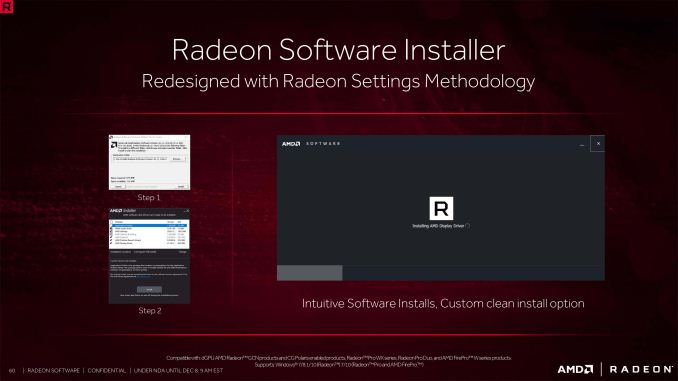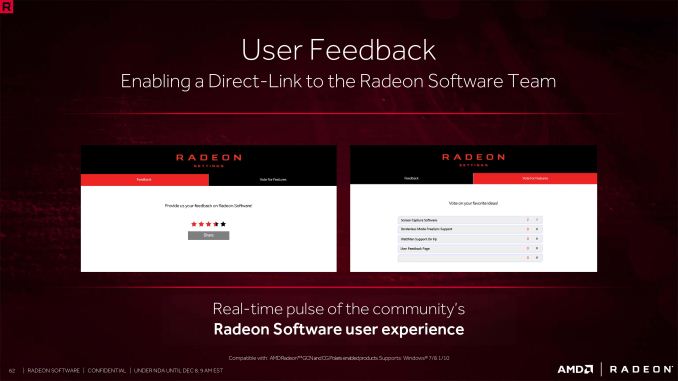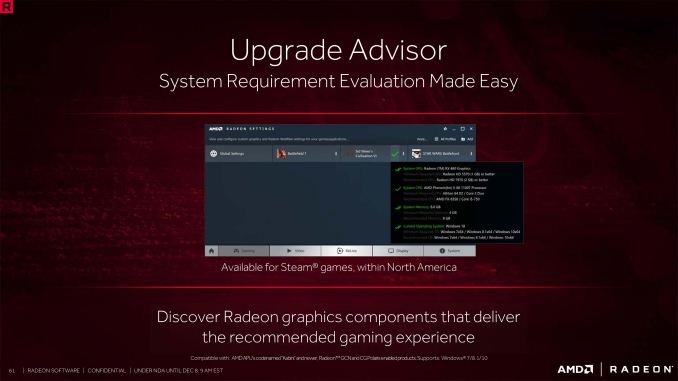AMD Delivers Crimson ReLive Drivers: Yearly Feature Update for Radeon Gamers and Professionals
by Ian Cutress on December 8, 2016 9:00 AM ESTReLive New Features (1)
For the users of the regular driver package used for gaming and general purpose home use, while the developer tools might not be much of interest there is certainly a lot going on with the interface worth mentioning. This all comes under the header of new features, and we’ll spend a few pages going over what will be new with Crimson ReLive.
Clean Installs
For anyone updating drivers, or moving between graphics card generations particularly on older systems, the only way to ensure 100% compatibility has been to have a fresh operating system devoid of any other programs. Ultimately the real-world is different, and for people using 3-5 year old systems who want to put in a new graphics card it can be a bit of an ordeal with driver conflicts or older files getting in the way. Over the last two years, the green team has had a ‘clean install’ option that promises to remove any trace of older software/software components and give a fresh install based on the installer package. Now this functionality comes to the red team as well.
Personally I’ve had driver conflicts come up mostly on older, much-used systems, or when changing a test-bed between multi-GPU configurations. Sometimes a reinstall of the same drivers over the top doesn’t do anything, leading to the loss of hair and four-letter expletives. Thankfully, this is designed to alleviate such a frustration. Clean Install is also offered with Radeon Pro and Radeon FirePro drivers.
User Feedback and Feature Requests
One of the problems with user feedback on PC related software is that it can be difficult to obtain. Typically users are self-selecting: they have issues and rate software badly, or have something to gain from a positive reply. There are focus groups that aim to be balanced, but they don’t always hit at detailed positive or negative aspects. There is no right way to do it (even the mobile stores have games that offer rewards for positive feedback), but AMD is attempting to do something to at least get ‘live’ data from Crimson ReLive.
ReLive will have a tab where users can offer their feedback, up to five stars (I’m unsure if the lower limit is 0 or 1 at this point), and I believe there will be an opportunity for users to give more detailed feedback in due course.
The other side of the coin is for feature requests. Most software manufacturers rely on forums and interpretation for user requests, or ideas come internally. AMD now has a tab where users can submit and vote on their favored features for upcoming software. This could be a game fix, back-porting software support for an older range of GPUs, increasing Freesync support or whatever submissions are taken. At some level I would assume AMD will keep an online list of submissions, and ones that are impossible (Freesync over VGA is something that can never happen) but end up rated high can be explained as to why it won’t happen. It will be an interesting development to see what comes through.
Upgrade Advisor
The fact that almost all games provide a ‘minimum’ and ‘recommended’ specification list allows a user to ensure a system is set up to provide a suitable experience. Through Crimson ReLive AMD will detect the current system and compare it to the requirements for detected games allowing the user to see if they meet the requirements or if the user needs to upgrade.
The system will give a tick when above the minimum requirements and a double tick when hitting the recommended. There is a caveat in all of this such that the recommendations will only occur on Steam Games for now, and for users in North America (I assume it detects this via the IP address).
At present the system does not offer recommendations as to what to buy (or where), or where to read reviews on potential upgrades. I highly recommend a site I know called AnandTech. I’m sure you’ve heard of it?













48 Comments
View All Comments
psychobriggsy - Friday, December 9, 2016 - link
AMD has been shipping proprietary AMDPRO drivers on Linux for quite some time, and if you want open source then AMD is the only choice really given Nvidia won't provide Pascal firmware images for Nouveau, and even then the AMD open source drivers are faster (in fact they compete very well with AMD's blobs on Linux now, they just don't provide OpenCL and Vulkan yet).Sure, if you game on Linux the Nvidia blobs are a bit faster than AMD overall, but it certainly isn't like a few years ago.
BrokenCrayons - Thursday, December 8, 2016 - link
Phrononix is my usual source for GPU benchmarks in Linux. I'm a regular reader over there and much of my current opinion was based on their performance analysis.YukaKun - Friday, December 9, 2016 - link
Benchmarks don't tell the day-to-day story. I have used both throughout the years and AMD has gotten ahead of the game now. People's complaints took some time, but they got their stuff together and they have zero things to have envy of nVidia's drivers.Performance not-withstanding, AMD is in a great shape now in the Linux world. In fact, I have to say it works wonders with SteamOS. Maybe I am a lucky one, but my 7970Ghz did not have a single issue playing all of the Linux ported titles and now the RX480 doesn't either. Outside of gaming, no issues either. It's been quiet sailing so far and I hope it remains that way.
I can't say the same thing with nVidia in my laptop. I still, after 10 years aprox, still don't have switchable graphics and I am scared of upgrading the proprietary binary, since I've had issues with it, even using genkernel.
Cheers!
BrokenCrayons - Friday, December 9, 2016 - link
Thanks for the information. I've been running a few older Nvidia GPUs (NVS 160m and 8400m GS) in my laptops without problems, but I don't use open source drivers. They experience has been very "sane" for my usage. I've yet to move my desktop with its GT 730 off Windows 7 which is largely a laziness thing as I already have an unused drive sitting in the case that just needs to be plugged in.I haven't personally tinkered with AMD graphics under Linux since I retired a couple of older laptops, one with a C-70 and another with an E-450 and their integrated GPUs. They were a pain to get working under Arch and Mint. I'm glad to hear that a current gen RX480 is working out for you. I might grab a RX460 in the next month or three and at that point I'll probably be more interested in transitioning to Linux and moving the system into a smaller case (microATX board in a full tower case...kinda a waste of space).
mr_tawan - Friday, December 9, 2016 - link
Bad news is, the latest AMD's RFC for DAL/DC get slammed today.psychobriggsy - Friday, December 9, 2016 - link
Yeah, I definitely sense that AMD's Linux devs were being held back by a higher up PHB regarding the HAL that was being imposed. Hopefully this major burn will allow them to do things properly at the kernel level even if it needs some linux-specific stuff in the drivers.IntoGraphics - Tuesday, January 3, 2017 - link
No.Read Phoronix for "It Looks Like AMDGPU DC (DAL) Will Not Be Accepted In The Linux Kernel" :
http://www.phoronix.com/scan.php?page=news_item&am...
VisS - Friday, December 9, 2016 - link
What Crap ?Colin1497 - Thursday, December 8, 2016 - link
Out of the box this looks really impressive. Time to start the download.One question: Technical reason that rebadged r9-2xx series cards get HDR10 in their r9-3xx guise while the original r9-2xx's don't? BIOS or marketing?
Colin1497 - Thursday, December 8, 2016 - link
Just realized how old I sound saying "start the download" like this was 1993 and it was going to take a week. It took a few seconds...